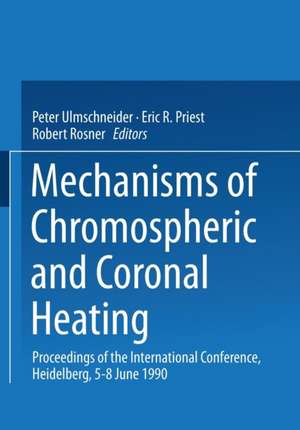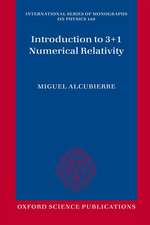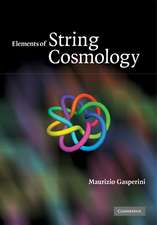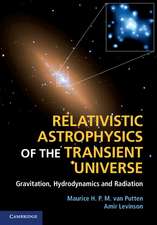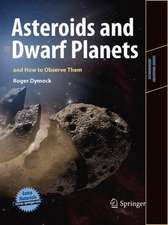Mechanisms of Chromospheric and Coronal Heating: Proceedings of the International Conference, Heidelberg, 5–8 June 1990
Editat de Peter Ulmschneider, Eric R. Priest, Robert Rosneren Limba Engleză Paperback – 2 oct 2013
Preț: 666.41 lei
Preț vechi: 784.01 lei
-15% Nou
Puncte Express: 1000
Preț estimativ în valută:
127.51€ • 133.50$ • 105.51£
127.51€ • 133.50$ • 105.51£
Carte tipărită la comandă
Livrare economică 07-21 aprilie
Preluare comenzi: 021 569.72.76
Specificații
ISBN-13: 9783642874574
ISBN-10: 3642874576
Pagini: 668
Ilustrații: XV, 649 p. 26 illus., 1 illus. in color.
Dimensiuni: 178 x 254 x 35 mm
Greutate: 1.14 kg
Ediția:Softcover reprint of the original 1st ed. 1991
Editura: Springer Berlin, Heidelberg
Colecția Springer
Locul publicării:Berlin, Heidelberg, Germany
ISBN-10: 3642874576
Pagini: 668
Ilustrații: XV, 649 p. 26 illus., 1 illus. in color.
Dimensiuni: 178 x 254 x 35 mm
Greutate: 1.14 kg
Ediția:Softcover reprint of the original 1st ed. 1991
Editura: Springer Berlin, Heidelberg
Colecția Springer
Locul publicării:Berlin, Heidelberg, Germany
Public țintă
ResearchDescriere
One of the great problems of astrophysics is the unanswered question about the origin and mechanism of chromospheric and coronal heating. Just how these outer stellar envelopes are heated is of fundamental importance, since all stars have hot chromospheric and coronal shells where the temperature rises to millions of degrees, comparable to the temperatures in the stars' cores. Here for the first time is a comprehensive inventory of the proposed chromospheric and coronal heating theories. The proposed heating processes are critically compared, and the observational evidence for the various mechanisms is reviewed. This is essential reading for all those working in such fields as stellar activity, radio and XUV emission, rotation, and mass loss, for whom a detailed and consistent presentation of our knowledge of chromospheric and coronal heating mechanisms is urgently needed.
Cuprins
1: Solar Observations.- Observations of Waves and Oscillations.- Observations of Waves and Oscillations in Solar Magnetic Fluxtube Concentrations.- The Generation of Long Period Acoustic Waves by Solar Global Oscillations.- Measurements of 1-Hz Coronal Oscillations at Total Eclipses and Their Implications for Coronal Heating.- Short-Term Oscillations in Green and Red Coronal Lines.- Height-Dependent Short-Period Oscillations in the Fe XIV (530.3 nm) Solar Corona Above a Sunspot Group Crossing the Limb.- On the Dynamics of Granulation in Active Regions and the Heating Problem.- Generation of Electric Currents and Waves on Magnetic Flux Tubes by Horizontal Velocities in the Photosphere.- On the Magnetic Field Activity in Solar Active Regions.- The Bright Points in the Ca II K-Line and Their Relation to the Inner Network Magnetic Structures.- K2V Cell Grains and Chromospheric Heating.- Wave Heating in Chromospheric Bright Points.- Do We Really Know What the Actual Chromospheric Heating Requirements Are?.- The Effects of Electron Scattering on the Si II 1816 Line in the Solar Chromosphere.- SIMURIS: a High Resolution Solar Physics Interferometric Mission in Answer to the Chromospheric and Coronal Heating Problem.- The Solar Ultraviolet Network (SUN).- HRTS Time Series Observations: Chromospheric and Coronal Heating.- High Spatial Resolution Observations of the Solar Transition Region: Spicules and Microflares.- New Models of the Chromosphere and Transition Region.- The Role of Particle Diffusion in the Lower Transition Region: Revised Interpretation of Emission Measures.- Why Heating is Not Necessary in the Transition Region or Upper Chromosphere.- Height-Dependent Solar Plage Temperature Distribution.- On the Temperature Inhomogeneity of the Lower Solar Corona.- Very High Resolution Solar X-ray Imaging.- Spectra of MHD Turbulence in Coronal Active Regions.- Observations of Coronal Bright Points and Implications for Coronal Heating Mechanisms.- Modelling Coronal Active Region Emission Patterns.- The Fe Ionization Equilibrium in the Solar Corona With a Non-Maxwellian Distribution Function.- Energetics of Solar Coronal Holes.- Coronal Radio Emission.- Implications of Microwaves for Heating and Particle Acceleration on the Sun.- Properties of Impulsive Events in a Polar Coronal Hole.- Explosive Instability in Solar Coronal Loops.- Signatures of Coronal Structures and Turbulence in the Solar Wind.- 2: Stellar Observations.- What Can Solar and Stellar Ultraviolet Observations Tell About Chromospheric and Coronal Heating Mechanisms?.- He I 5876 Å Line As an Indicator of Chromospheric Heating in Young F-Type MS Stars.- Chromospheric Modelling of Active Regions on AU Mic.- New Clues to Atmospheric Heating Processes in Luminous Cool Stars.- Chromospheres of Cool Non-Mira Giant Stars.- What Can Observations of Giants and Supergiant Stars Tell Us About Chromospheric and Coronal Heating?.- Chromospheric Activity in Late-Type Giants and Supergiants: Constraints on Heating Theories.- Coronal Heating and the Dividing Line.- An Infrared Perspective on Chromospheres.- Magnetic Activity Across the Hertzsprung-Russell Diagram.- Relations Between Activity and Magnetic Fields.- Recent Measurements of Stellar Magnetic Fields.- Chromospheric/Coronal Emission Correlations in ‘Quiescent’ and Eruptive Phenomena in M-Dwarf Stars.- Global Electrodynamic Coupling in Stellar Atmospheres.- Implications for Coronal Heating Theories from Stellar X-ray Observations.- Empirical Constraints on Coronal Heating Processes.- Minimum Coronal Energy Requirements: Constraints for Heating Mechanisms.- Sun-Hot Star Contrast in Chromospheric/Coronal Te(r). Nonradiative Heating vs. Outflow Enhanced Opacity.- Formation of Chromospheres and Coronae of Accretion Disks by Viscous Dissipation.- 3: Wave Heating Mechanisms.- Acoustic Heating.- On the Intrinsic Difficulty of Producing Stellar Coronae With Acoustic Waves.- The Effect of Waves on Optically Thin Transition Region Lines.- Heating of the Solar Atmosphere by Spicules.- Nonlinear Pulse Propagation in a Stratified Atmosphere.- The Shock Wave Heating Mechanism of Pulsating Star Chromospheres.- Ionization Pumping.- Shock Amplification by Radiation.- Recent Developments in Theories of Wave Generation.- Generation of Acoustic Flux Derived from Numerical Simulations of the Solar Granular Convection.- Magnetoacoustic Waves and Their Generation by Convection.- Magnetoacoustic Heating of the Solar Chromosphere.- Effects of Line-Tying and Non-Uniformities on Thermal Instabilities and Slow MHD Modes.- Heating in Intense Flux Tubes.- Line Simulation of Solar Structures Permeated by Acoustic and MHD-Waves.- Damping of Shocks in Magnetic Flux Tubes.- Heating of the Solar Chromosphere by MHD-Waves.- Alfvén Waves.- Reflection of Alfvén Waves and Heating in Solar Coronal Holes.- Alfvén Wave Propagation in a Solar Magnetic Structure.- On Propagation and Absorption of Alfvén Waves in Coronal Loops.- Magnetic Confinement, Alfvén Wave Reflection, and the Origin of X-ray and Mass Loss “Dividing Lines”.- Heating in Stochastic Magnetic Fields.- Resonance Absorption Heating.- Resonant Absorption of MHD Waves in Magnetic Loops in the Solar Corona.- On the Time Scales and the Efficiency of Solar Coronal Loop Heating by Resonant Absorption.- Line-Tying Effects on Stability and Heating of Solar Coronal Loops.- Coronal Loop Heating by Discrete Alfvén Waves.- Magnetohydrodynamic Surface Waves.- Magnetoacoustic-Gravity Surface Waves.- Properties of Non-Parallel Magnetoacoustic Surface Waves.- Viscous Damping of Magnetohydrodynamic Surface Waves.- Coronal Loop Heating by the Fast Surface Wave.- 4: Electrodynamic Heating Mechanisms.- The Formation of Current Sheets and Coronal Heating.- Current Sheet Formation in Force-Free Magnetic Fields.- Two-Dimensional Magnetic Neutral Points.- The Significance of Magnetic Null Points.- Effect of Coronal Heating on Coronal Arcades.- Heating by Field Aligned DC Joule Dissipation.- Joule Heating in the Sun’s Lower Transition Region.- Plasma Heating by Current Sheets in Solar Active Regions.- Chromosphere Generation in Magnetic Flux-Tubes.- Coronal Magnetic Structure: the Role of Ideal MHD Invariants.- Current Helicity and the Generation of Magnetic Field Aligned Currents.- Nonlinear Evolution of a Force-Free Arcade Field Driven by Shear Flow.- Two-Dimensional Magnetic Reconnection.- Magnetic Field Annihilation Within a Stagnation Point Flow.- Three-Dimensional Magnetic Reconnection: Basic Concepts.- Atmospheric Heating in Emerging Flux Regions.- Micro/Nanoflare Coronal Heating.- Numerical Simulation of Microflare Evolution in the Solar Transition Region and Corona.- Coronal Heating by Nanoflares: Plasma Dynamics of Elementary Events.- Coronal Heating by Nanoflares: Possible Evidence of Plasmoids in Radio Occultation Data.- Author Index.- List of Participants.
